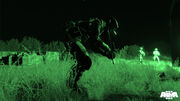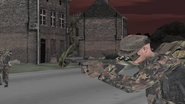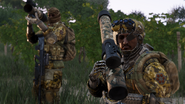NV Goggles (full name: Night Vision Goggles) are optoelectronic devices.
Overview[]

CSAT soldier with night vision activated.
NVGs are head-worn devices designed to intensify existing light. Throughout the series, NVGs have always represented a quintessential technological advantage for any modern army against low-tech enemies.
While night vision is activated, it is possible to see the lasers beams projected by weapon-mounted laser pointers. Likewise, it is also possible to spot the periodic blinking emitted by infrared strobes.
The main downside to NVGs stems from the limited field of view while they remain activated, even if they are of a non-monocular design. Notable exceptions include helmets worn by fixed-wing jet pilots in ArmA 3, as well as any panoramic vision helmets worn by some special operations units.
ArmA: Cold War Assault[]
In Cold War Assault, NVGs are seldom available and are only issued to U.S./Soviet vehicle crews and specific special operations units (i.e. U.S. Black Ops and Soviet Spetsnaz).
They offer a significant advantage over conventional grenade launcher flares as only the wearer will not risk exposing themselves unless the opposing side also retains access to NVGs.
ArmA: Armed Assault[]
| « | Night vision goggles are intended for observation and terrain orientation at night. They work by intensifying the already available light in conditions of low illumination, using, for instance, light from the moon or the stars. Library Description
|
» |
In Armed Assault, NVGs are mostly used by U.S. Army soldiers. Some SLA troops, Especas SOF, pilots, and Royal Guards of the RACS do have access to a pair, but they are otherwise solely the domain of U.S. forces.
Functionally, they remain identical to their Cold War Assault predecessors and restrict the wearer's field of view upon activation. As before, they provide the same advantages over UGL-fired flares.
ArmA 2[]
| « | Night vision goggles are intended for observation and terrain orientation at night. They work by intensifying the already available light in conditions of low illumination using, for instance, light from the moon or the stars. Armoury Description
|
» |
In ArmA 2, NVGs are more commonly available compared to in Armed Assault and are utilised by all Western BLUFOR factions with the exception of specific non-combat/support troops and less advanced BLUFOR-aligned factions.
However, aside from Russian officers, team/squad leaders, and Spetsnaz operatives, most REDFOR factions (including regular Takistani troops) do not have access to NVGs. For the majority of REDFOR units that are not the crews of armoured fighting vehicles, they continue to rely on flares or night vision scopes mounted on certain weapon platforms.
NVGs will now allow the user to see the flashes emitted by infrared strobes. The blinking from IR Marker Strobes can be seen from afar while IR Targeting Strobes can be "detected" by NVG-wearing infantry. Pilots flying aircraft armed with laser-guided bombs can also lock onto the latter, provided that they are within range of the strobe.
Additionally, IR beams projected by laser pointers can be seen clearly when NVGs are activated. This can allow friendly forces to visually point out targets, though it runs the risk of exposing the user's location if the opposite side also has access to night vision-capable equipment.
ArmA 3[]
| « | To use night vision, you need to have night vision optics mounted on a weapon, helmet or vehicle. Use IR flares and laser pointers to mark objects and locations when using night vision. They will remain unseen by the enemy but soldiers with night vision will be able to see them clearly. Field Manual
|
» |
In ArmA 3, NVGs are universally available to all BLUFOR, REDFOR, and INDFOR factions with the exception of a few non-state actor groups.
ArmA 3 is the first game in the series to feature multiple NVG variants rather a single universal model. Conventional NATO, AAF and LDF infantry for instance, wear basic binocular-type goggles. On the other hand, both Mediterranean/Pacific CSAT forces and Russian Spetnsnaz operatives utilise the Compact NVG, though it is essentially identical to its basic counterpart in all but appearance.
Fixed-wing aircrews and pilots retain access to helmets with integrated night vision capability. Unlike their externally-worn counterparts, the helmets provide a full unobstructed field-of-view upon activation. This also applies to CSAT SOF, though they wear ballistic-resistant helmets which offer the same enhanced vision capability that is directly integrated into the helmet itself.
Lastly, in addition to allowing the user to clearly see IR beams that are being projected from a laser pointer, NVGs also allow the wearer to see "invisible" light sources from IR flashlights.
Standard[]
The standard-issue NVGs are available to all primary factions with the exception of some guerilla sub-factions and conventional Pacific CSAT forces/Russian Spetsnaz operatives.
It weighs 20 "mass" units and comes in four camouflage varieties: Sand, Black, Olive, and Tropical.
ENVG-II[]
| « | ENVG-II - Mark 2 Enhanced Night Vision Goggles are all-in-one goggles used by members of CTRG forces consisting of TI white-hot and NV. They are relatively light and compatible with NATO gear. Field Manual
|
» |
NATO special operations units, mainly CTRG black ops and LDF pathfinders, don ENVG-II multi-vision goggles. They are available in three colour schemes: Black, Green or Grey. ENVG-IIs have a weight of 30 "mass" units.
One major difference to standard-issue NVGs is that they allow the user to switch between a night or white-hot thermal vision mode. However, ENVG-IIs are not considered to be panoramic and will not provide a fullscreen view of the wearer's surroundings.
Compact NVG[]
| « | Next generation CSAT night vision combat googles. They are compatible with common CSAT helmets. They use multiple lenses for greater reliability and their power source can last a long time. Field Manual
|
» |
The Compact NVG is a unique CSAT-exclusive derivative that is primarily utilised by Pacific CSAT forces and Russian Spetsnaz operatives.
Compact NVGs have a weight of 20 "mass" units and are available in four varieties: Arid, Urban, Tropic, and Green. As with the ENVG-II, Compact NVGs are not panoramic and will not provide the wearer with a fullscreen view of their surroundings.
ARMA Reforger[]
ARMA Reforger currently does not feature NVGs.
Gallery[]
Trivia[]
|
References[]
|
External links[]
See also[]
| Equipment | |
|---|---|
| Non-lethal | Binoculars • Chemical Detector • Chemlight • Compass • Entrenching Tool • Flares • Flashlight • Fuel Container • GPS • Infrared Strobe • Landmine Marker • Laser Designator • Mine Detector • Night Vision Goggles • Parachute • Radio • Rangefinder • Repair Tool • Resupply Pack • Smoke Grenade • Spectrum Device • Toolkit • UAV Terminal • Watch |
| Lethal | Explosives • Hand Grenades • Landmines • Underbarrel grenade launcher (Cold War Assault, Armed Assault, ArmA 2, ArmA 3, Reforger) |
| Medical | Bandage • First Aid Kit • Medikit • Morphine Injector • Saline Solution • Tourniquet |














